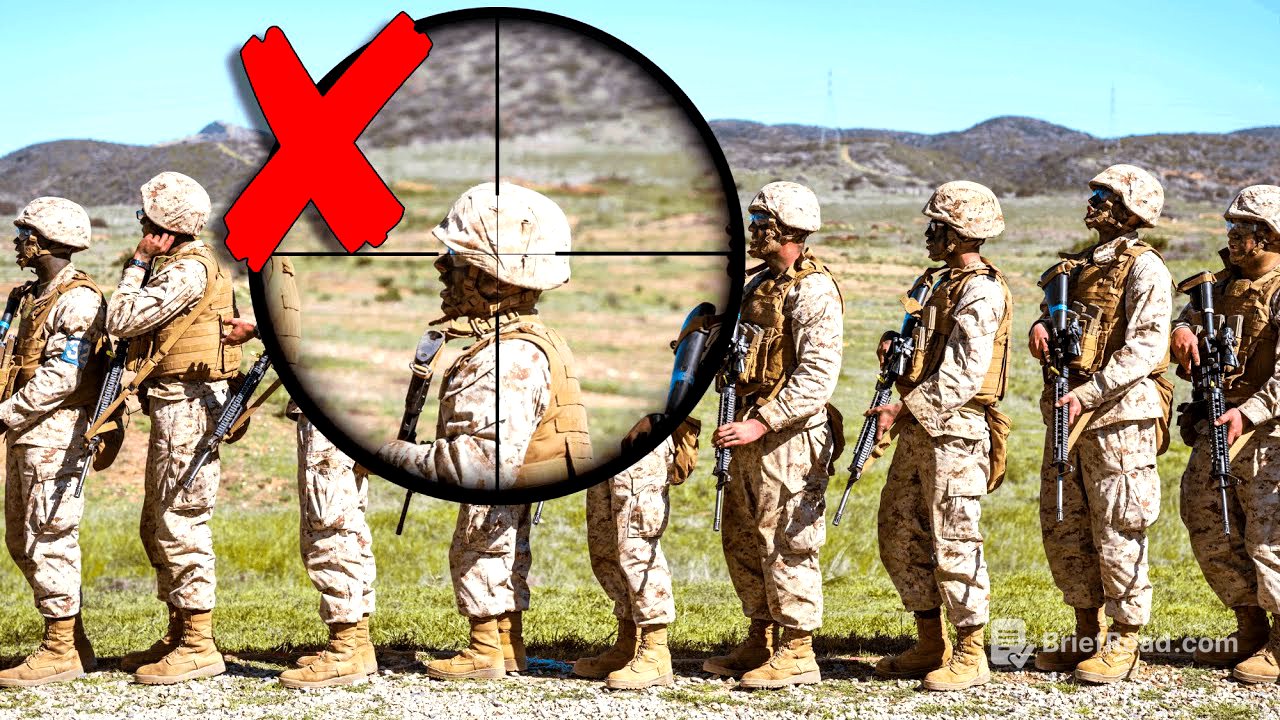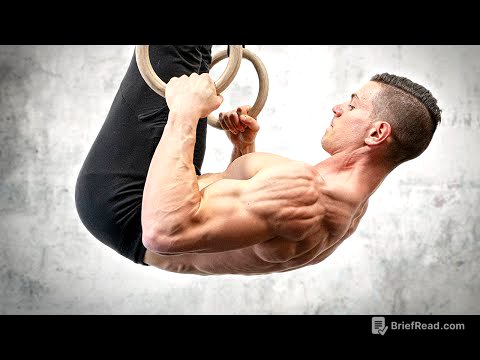TLDR;
This video explores the world of military snipers, covering their training, tactics, and impact on the battlefield. It discusses the challenges they face, including environmental factors, psychological pressures, and countermeasures employed against them. The video also touches on the evolving role of snipers in modern warfare, particularly with the rise of drone technology.
- Snipers prioritize concealment and reconnaissance over direct engagement.
- Environmental factors like wind, gravity, and the Coriolis effect significantly impact a sniper's accuracy.
- Spotters play a crucial role in assisting snipers with calculations and adjustments.
- Drones are increasingly used for reconnaissance and targeted strikes, challenging the traditional role of snipers.
Sniper At Work [0:00]
Snipers prioritize remaining unseen, often spending extended periods in concealed positions. The South Armagh Sniper, part of the IRA, exemplified this during their campaign against the British Army. The video will cover the story of a US Army medic who survived a sniper shot and became a hero, why snipers don't aim for headshots, the impact of Earth's rotation on sniping, and the increasing replacement of snipers by drones in modern warfare.
The US Army medic shot by sniper [0:46]
In 2005, US Army medic Stephen Tschiderer was shot in the chest by an Iraqi insurgent sniper, an event captured on video by the sniper's companions. Protected by his body armor, Tschiderer identified the sniper's location, leading to a chase. After capturing the sniper, Tschiderer, true to his role as a medic, provided medical aid to the injured insurgent. Tschiderer downplayed any notion of heroism, stating he was simply doing his job as a soldier and medic.
Snipers are not visible [2:06]
Snipers prioritize remaining unseen, even when in plain sight, with the exception of deterrent patrols like those on the White House roof. A visual test challenges viewers to spot a sniper team, consisting of a sniper and a spotter, highlighting their ability to blend into their surroundings. Despite their marksmanship, snipers aren't guaranteed to hit their target on the first attempt.
What if a sniper misses the shot? [2:55]
In ideal conditions, a sniper can hit a target up to 1,000 yards away on the first try. If a shot misses, the "splash," or point of impact, provides crucial information for adjustments. The spotter offers quick, precise feedback to the sniper, enabling them to correct their aim for subsequent shots.
Who is more experienced? Sniper or Spotter? [3:30]
The spotter is typically more experienced than the sniper. Despite common perception, the spotter is responsible for calculations related to wind and necessary corrections, essentially guiding the shooter. The spotter dictates the shooter's actions, leveraging their expertise to ensure accuracy.
Impact of wind on sniping accuracy [4:02]
Crosswind is a significant factor affecting a shot's accuracy. Spotters use wind meters to measure wind speed and direction, but variations between the spotter's location and the target complicate the process. Gusty winds and differing speeds further challenge accurate shot placement.
Impact of gravity on sniping accuracy [4:21]
Gravity constantly pulls the bullet downwards, causing it to follow an arc rather than a straight line. Snipers must aim higher above the target, especially at longer distances, to compensate for this effect. Adjustments are typically made using elevation and windage knobs on the scope, aligning the target with the crosshairs.
Impact of the Coriolis Effect on sniping accuracy [5:08]
The Coriolis Effect, caused by Earth's rotation, also influences bullet trajectory. As the Earth rotates from west to east, it moves beneath the bullet's path. When shooting west, the target rotates upwards, causing the bullet to hit lower. Conversely, shooting east results in the target dropping down, causing the bullet to hit higher.
WarPath Ace Shooter (sponsor) [5:42]
WarPath Ace Shooter is a mobile game that combines sniping with real-time strategy. Players use different firearms for each mission, experiencing realistic recoil. The game includes base building, resource management, and alliance options. Players can use long-range units, combined arms tactics, and air superiority. A mini-game offers opportunities to win physical rewards.
How do snipers measure distance? [7:02]
Accurate distance measurement is crucial for accounting for wind, gravity, and the Coriolis effect. An incorrect estimation can cause the bullet to miss the target. Spotters use laser rangefinders, which send a laser pulse to the target and measure the return time. Military rangefinders can operate from 1.2 to 15 miles and are combined with monoculars or binoculars. More powerful rangefinders can see up to 25 miles.
The longest sniper kill world record [8:02]
In November 2023, Vyacheslav Kovalsky, a 58-year-old Ukrainian sniper, set a new world record for the longest sniper kill, eliminating a Russian soldier from 2.3 miles away. The bullet traveled for approximately 9 seconds. Video evidence was released to verify the claim.
Breathing control and trigger control [8:29]
A sniper's breathing and trigger pull can significantly impact accuracy, especially at long distances. Even a heartbeat can affect the shot. Snipers must remain calm to reduce their heart rate and time their trigger pull between heartbeats.
Why snipers don't go for headshot [9:07]
Military snipers generally avoid headshots due to the head's small size and constant movement, making it a difficult target at longer distances. Instead, they aim for the center mass of the upper chest, providing a larger target and higher probability of a kill. Police snipers, operating at shorter distances, may attempt headshots, especially when a target is behind a hostage.
How aerial snipers work? [9:50]
Aerial snipers face the challenge of hitting moving targets from a moving helicopter. Robots can assist in determining shot effectiveness. Aerial snipers use an X harness or sling to stabilize their rifle and absorb vibrations. They typically engage targets within 220 yards, much closer than ground snipers. Hovering for a shot increases vulnerability, so machine guns are sometimes preferred. The helicopter pilot assists as a spotter, maintaining stability and positioning.
How do snipers hide? (Ghillie suit) [11:09]
A sniper's ability to stay hidden is crucial. The Ghillie suit is a primary tool for concealment, but it requires "vegging up," which involves attaching local vegetation to break up the human body's recognizable curves. Vegging up varies by terrain.
Why snipers pants don't have zippers [12:19]
Sniper pants use buttons instead of zippers or Velcro to avoid issues with dirt and debris during crawling. Cordura 500 fabric protects against rot, mildew, and abrasion. Face painting and rifle camouflage are also important for concealment.
Stalking training for snipers [13:15]
Stalking is a difficult aspect of sniper training, requiring slow, patient, and methodical movement. Trainees spend hours moving through wooded areas to approach and "shoot" instructors, who try to find them first.
Sniper's most important role (Reconnaissance) [14:02]
Reconnaissance is a sniper's most critical role, accounting for about 90% of their activities. Snipers observe enemy movements and report information for artillery fire or air strikes. They also assess the effectiveness of strikes. Survival skills and land navigation are essential. Teamwork between the spotter and sniper is key.
Sniper school (Fort Benning) [14:55]
The Army Sniper School at Fort Benning, Georgia, offers a seven-week qualification course open to various military branches and federal agencies. In 2015, the US military opened combat jobs to women, and Sgt. Maciel Hay became the first active-duty female sniper in November 2023. Only 4 out of 10 candidates typically pass the course.
Psychological impact of snipers [15:28]
Snipers have a significant psychological impact, similar to landmines and IEDs, creating constant stress and fear in opposing forces. Snipers pose a constant threat, with a high "per event" lethality, and it’s quite difficult for the other side to strike back at them. It takes a specific type of person to be a sniper.
What happens to captured snipers? [16:16]
Captured snipers are often mistreated more than regular soldiers due to the perceived low risk of retaliation they face. Snipers in dangerous situations may discard their Ghillie suit and rifle to conceal their identity if captured.
Sniper countermeasures [16:51]
Passive countermeasures against snipers include officers removing or subduing rank insignia and avoiding saluting in the open. Active countermeasures involve using counter-snipers and canine units.
Drones are replacing snipers [17:36]
Drones are increasingly replacing snipers, proving effective in modern warfare, such as in the Ukraine war. They can drop munitions and provide reconnaissance for artillery adjustments. Drones with thermal cameras can expose even well-camouflaged snipers by detecting their body heat.









